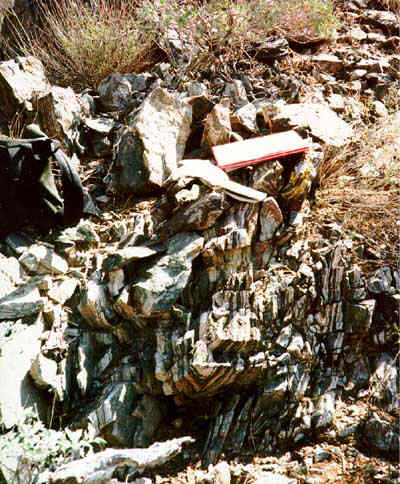 Proterozoic Structures
Proterozoic Structures  Proterozoic Structures
Proterozoic Structures
The oldest (S1) foliation, defined by aligment of
mineral grains (mainly mica and amphibole) and by compositional
banding, is present in most of the Proterozoic units. In
areas not disturbed by later deformation, this foliation strikes
N30E to N60E and dips moderately to steeply to the southeast
(figure 4). The S1 foliation is gently folded both in the
southwestern and northern parts of the range (figure 5, figure
8). This folding is manifested by two shallowly plunging
antiforms that trend N40E, have a gentle interlimb angle (~130')
and a fold width of 3-5km.
A younger foliation is
found in the western part of the range. This foliation (S2)
trends N30W and dips steeply to the northeast (figure 6).
The foliation is defined by alignment of mineral grains,
stretched feldspars, aligned silmanite crystals and folding of
the S1 foliation to orientations parallel to S2 (figure 7).
This foliation is generaly constrained to distinct shear zones
which display a east side down sense of shear (figure 9).
The S1 foliation can be correlated to
the main NE trending foliation of the Transition Zone. The
later folding of S1 and the presence of S2 are not seen in the
Transistion Zone and may represent either local structural events
or different deformational behavior in the middle crust than the
upper crust, which is found in the Transition Zone.
 Figure 7. Photograph of
S1 foliation (banding of gneiss) folded in a S2 shear zone.
Figure 7. Photograph of
S1 foliation (banding of gneiss) folded in a S2 shear zone.
Bedrock Geology Project
Abstract
Overview
Proterozoic rock units
Proterozoic Structures
Remote Sensing techniques
References and
Acknowledgments
Geology and Web pages by Steven Wood and Stephen J. Reynolds, Dept. of Geology, Arizona State University, Tempe, AZ -- July 1998